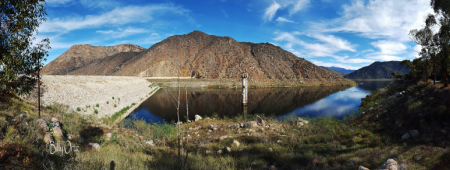
By Miriam Raftery
Photo by Billy Ortiz: El Capitan Dam in Lakeside, ranked “fair” for safety, has an “extremely high “downstream hazard status for potential loss of life and property damage.
September 2, 2017 (San Diego’s East County) - The State of California on Friday released data on dam safety in California which found nine percent of dams statewide fall below satisfactory and could pose potential hazards in severe storms or earthquakes—including nine dams in San Diego County.
The data previously, kept secret due to terrorism concerns, was disclosed after the Oroville dam spillway failure triggered concerns raised by the public and media, including East County Magazine, which recently put in a request for dam safety data in San Diego.
A report with listings by county reveals that of 54 dams in San Diego County, nine are listed in “fair” condition and the rest are in satisfactory, the highest rating. No local dams were ranked poor or unsatisfactory.
But "fair" is not a passing grade when it comes to dams. Fair means the dams are likely to hold up under normal capacity but could have problems in an earthquake or with excessive precipitation, so improvements are needed to assure public safety.
The dams rated fair locally are at reservoirs at Lake Barrett, El Capitan in lakeside, Lake Hodges, Lake Morena in Campo, Mt. Woodson in Ramona, Lake Murray, Savage Dam at Otay, Sweetwater Main dam in Bonita, and Lake Wohlford in Escondido.
Of those 9 dams listed in fair condition locally, eight also have downstream hazards rated “extremely high” meaning “considerable” loss of human life and property is likely. The extremely high risk classification is given to dams that may impact highly populated areas or critical infrastructure, or that have short evacuation times. One, Mt. Woodson, has a “high” downstream hazard.
Four of the local dams are listed as receiving additional spillway evaluation. They are El Capitan, Lake Hodges, Morena, and Savage. Statewide, 94 dams are on the additional spillway evaluation list.
Some of the dams with a “fair” rating have reservoirs that have been mostly drained by the city of San Diego to meet its water supply needs, such as Morena and Barrett, at 8% and 36% capacity currently, according to records from the city of San Diego. Six years of drought also drained down water through evaporation, though heavy winter rains partially replenished water levels. Some are nearly full, such as Lake Murray at 89%, while others, such as El Capitan at 37% capacity, are far from full.
But even when only partially filled, an earthquake could pose risks to those downstream in some areas if a dam were to rupture. More extreme storms due to climate change could also heighten risks from in the past.
Most of these dams with potential problems locally are owned by the City of San Diego. Mt. Woodson is owned by Ramona Municipal Water District, Sweetwater Main by the Sweetwater Authority, and Lake Wohlford by the City of Escondido.
10 News ran a story on the $7.5 million upgrades at Sweetwater, a concrete dam built in 1888 and recently deemed “unsafe.” The Sweetwater dam is 112 feet high and 700 feet wide.
Of greatest concern in East County is the El Capitan Dam in Lakeside, a hydraulic fill dam made of rocks, built in 1934. The dam is 237 feet tall and 1,170 feet wide, but no longer meets state standards.
ECM has requested additional information on the 9 local dams that failed to receive satisfactory ratings, including the 4 slated for spillway evaluations, to learn why and find out what steps are planned to make them safer.







Comments
Bats
The bat houses were on the side of the dam facing downstream attached to a handrail. There are large bright floodlights the Border Patrol had the City install to illuminate the canyon below the dam that attracted tens of thousands of moths and mosquito's. The doors to the interior of the dam were sealed to keep the bats out. The droppings went to a small pond at the base of the dam.
So, the idea was to protect the bats because they control insects.
The canyon wasn't used much for smuggling because it has very steep walls and Lower Otay County Park is more accessible.
https://www.google.com/search?q=Savage+Dam+images+Chula+Vista+California...
See also this info about the Congress Avenue Bridge in Austin, thousands of people show p to watch the bats emerge.
http://www.batcon.org/index.php/our-work/regions/usa-canada/protect-mega...
Savage Dam
When I was in Savage Dam it was full of bats and guano. There is a stairway that leads to the bottom of the dam. The City of SD used water tankers to flush the guano into the riverbed below the dam and put bat houses on the dam. Depositing the waste was likely a violation of the law but due to the isolated location no one knew.
Tom, why did they put bat houses on the dam?
Clearly this would attract bats, and the guano (bat droppings) in a public drinking water source could create a health hazard.